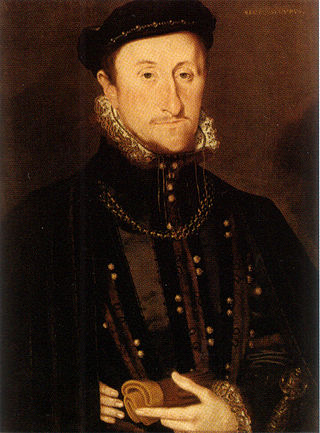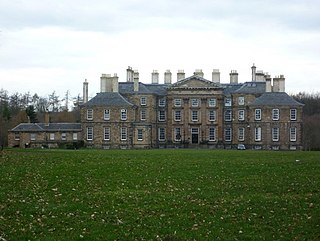Branxholme Castle is a five-storey tower at Branxholme, about 3 miles south-west of Hawick in the Borders region of Scotland.
Contents


Branxholme Castle is a five-storey tower at Branxholme, about 3 miles south-west of Hawick in the Borders region of Scotland.


The present castle is on land owned by the Clan Scott since 1420. The Earl of Northumberland burned the first castle in 1532. [1] The rebuilt castle held out against the English in the War of the Rough Wooing in 1547. In January 1548 English observers noted that cannon would be needed to capture Branxholme. [2]
In 1570 the Scotts themselves slighted and burnt the castle. On 20 April 1570, an English army under the Earl of Sussex and Lord Hunsdon arrived and Branxholm was described as "a very strong house and well set, and very pleasant gardens and orchards about it." They completed the work of demolition with gunpowder. [3]
In 1571 Sir Walter Scott of Buccleuch commenced rebuilding and his widow Margaret Douglas completed the work in October 1576. [4] The Scotts were during these troubled years frequently the Wardens of the Middle March. The castle was extensively remodelled by William Burn in 1837 for the 5th Duke of Buccleuch. The Branksome Hall School in Toronto, Canada, is named after this castle, and has been given a replica of a mantle from the castle.
Branxholme castle consists of a sixteenth-century tower house of five storeys, altered and incorporated in a later mansion. There are vaulted chambers in the basement, and a newel stair.
Walter Scott, 1st Lord Scott of Buccleuch was the “bauld Buccleuch” of the Border ballad Kinmont Willie . The narrative poem The Lay of the Last Minstrel [5] by the poet and novelist Sir Walter Scott celebrates the success of Baron Henry of Cranston in securing the hand of Lady Margaret of Branksome Hall.

James Stewart, 1st Earl of Moray was a member of the House of Stewart as the illegitimate son of King James V of Scotland. At times a supporter of his half-sister Mary, Queen of Scots, he was the regent of Scotland for his half-nephew, the infant King James VI, from 1567 until his assassination in 1570. He was the first head of government to be assassinated with a firearm.

Duke of Buccleuch, formerly also spelt Duke of Buccleugh, is a title in the Peerage of Scotland created twice on 20 April 1663, first for James Scott, 1st Duke of Monmouth, and second suo jure for his wife Anne Scott, 4th Countess of Buccleuch. Monmouth, the eldest illegitimate son of King Charles II, was attainted after rebelling against his uncle King James II and VII, but his wife's title was unaffected and passed on to their descendants, who have successively borne the surnames Scott, Montagu-Scott, Montagu Douglas Scott and Scott again. In 1810, the 3rd Duke of Buccleuch inherited the Dukedom of Queensberry, also in the Peerage of Scotland, thus separating that title from the Marquessate of Queensberry.

Clan Kerr is a Scottish clan whose origins lie in the Scottish Borders. During the Middle Ages, it was one of the prominent border reiver clans along the present-day Anglo-Scottish border and played an important role in the history of the Border country of Scotland.

Dalkeith Palace is a country house in Dalkeith, Midlothian, Scotland. It was the seat of the Dukes of Buccleuch from 1642 until 1914, and is owned by the Buccleuch Living Heritage Trust. The present palace was built 1701–1711 on the site of the medieval Dalkeith Castle, and was latterly renamed Dalkeith House.

Clan Scott is a Scottish clan and is recognised as such by the Lord Lyon King of Arms. Historically the clan was based in the Scottish Borders.
William Armstrong of Kinmont or Kinmont Willie was a Scottish border reiver and outlaw active in the Anglo-Scottish Border country in the last decades of the 16th century.

Walter Scott, 5th of Buccleuch, 1st Lord Scott of Buccleuch was a Scottish nobleman and famous border reiver, known as the "Bold Buccleuch" and leader of Kinmont Willie's Raid.

Liddesdale, the valley of the Liddel Water, in the County of Roxburgh, southern Scotland, extends in a south-westerly direction from the vicinity of Peel Fell to the River Esk, a distance of 21 miles (34 km). The Waverley route of the North British Railway runs down the dale, and the Catrail, or Picts' Dyke, crosses its head.

Clan Douglas is an ancient clan or noble house from the Scottish Lowlands.

The Lay of the Last Minstrel (1805) is a narrative poem in six cantos with copious antiquarian notes by Walter Scott. Set in the Scottish Borders in the mid-16th century, it is represented within the work as being sung by a minstrel late in the 1600s.

Newark Tower is a large, ruined tower house standing in the grounds of Bowhill House, in the valley of the Yarrow Water three miles west of Selkirk in the Scottish Borders. In addition to the keep, sections of a gatehouse and wall survive. It has been designated a scheduled monument by Historic Environment Scotland.

Dryhope Tower is a ruined Scottish peel tower in the valley of the Yarrow Water, in the historic county of Selkirkshire, now part of the Scottish Borders. It lies approximately equidistant between the burghs of Moffat and Selkirk, and defended the north eastern end of St Mary's Loch. The site itself was protected on two sides, to the east by the Dryhope Burn and to the west by the Kirkstead Burn.

Branxholme is a hamlet in the Scottish Borders area of Scotland, overlooking the River Teviot, 3 miles southwest of Hawick, on the A7 road to Langholm.
Janet Beaton, Lady of Branxholme and Buccleugh (1519–1569) was an aristocratic Scottish woman and a mistress of James Hepburn, Earl of Bothwell. She had a total of five husbands. One of her nieces was Mary Beaton, one of the four ladies-in-waiting of Mary, Queen of Scots, known in history as the four Marys. In her lifetime, she was accused of having been a witch. Janet was immortalised as Sir Walter Scott's Wizard Lady of Branxholm in his celebrated narrative poem "Lay of the Last Minstrel".

Sir Walter Scott, 1st of Branxholme, 3rd of Buccleuch, known as "Wicked Wat", was a nobleman of the Scottish Borders and the chief of Clan Scott who briefly served as Warden of the Middle March He was an "inveterate English hater" active in the wars known as The Rough Wooing and a noted Border reiver. He was killed on Edinburgh High Street in a feud with Clan Kerr in 1552. His great-grandson was Sir Walter Scott, 1st Lord Scott of Buccleuch, the "Bold Buccleuch" (1565–1611), a border reiver famed for his role in the rescue of Kinmont Willie Armstrong.

Walter Scott, 4th Baron of Buccleuch (1549–1574) was head of the Border family of Scott and, despite his youth, played a prominent part in the turbulent politics of 16th century Scotland.
Sir Walter Ker of Cessford was Scottish warden of the Middle March on the Anglo-Scottish border.
William Borthwick, 6th Lord Borthwick was a Scottish landowner.
Bedrule Castle is a ruined 13th-century castle in the Rule Valley, in the Scottish Borders area of Scotland.
Margaret Douglas, Countess of Bothwell was a Scottish aristocrat and courtier.